Water supply scheme from the well - the main features of
As you know, it is not always possible to connect to the water supply network, especially in private houses and cottages. Often they are located away from the communications network, and if electricity is everywhere, then laying the water supply is a very expensive process. That is why the well is the most rational solution in a number of cases.
It is worth noting that often the water supply lines laid for a long time, give water of disgusting quality. In this case, the well will also be an excellent solution, because the quality of water from an artesian source will be much higher.

The main types of wells
Note that water intakes at the sites are of two main types. Each has its own advantages and disadvantages, which we consider in more detail.
Sandy springs
The main differences of this type are the following factors:
- The possibility of water intake device do it yourself, That is why many are inclined to this decision.
- The depth from which the water is taken is on average 20-30 meters.. Water is cleaner than in wells, but various impurities often get into it due to its proximity to groundwater.
- Typically, the performance of such a source is small and can not provide large needs..
- Lifetime does not exceed 10 years, but most often this figure is even less. And to drill a hole every few years is not cheap pleasure.
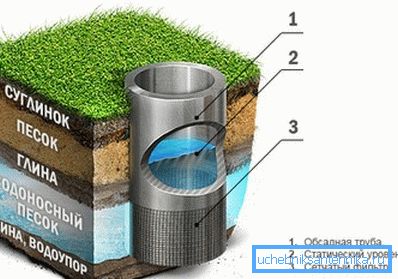
Artesian springs
This type has a number of undeniable advantages:
- The water intake is equipped at a depth of 20 meters and more, so that you get water of excellent quality without any impurities.
- Very impressive supply of water, which is enough even for a large family, because the performance can reach even 10 m3 at one o'clock.
- Such sources serve from half a century and even more than compare favorably with sandy ones.
- Due to the great depth and complexity of the work, it is practically impossible to do this type of water intake with your own hands. Here only professionals with the appropriate set of equipment will help.
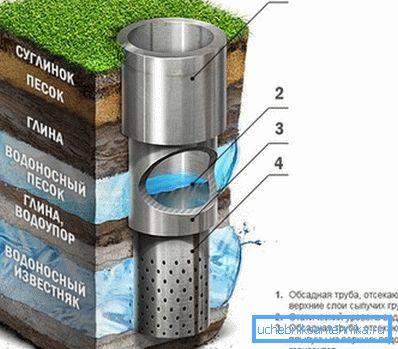
In view of all the above factors, it can be concluded that the second option is much preferable in view of the many advantages.
Equipment required for water supply
It is worth noting that systems may vary depending on many factors, but the most important of them is the type of pump used in the system. The depth of the source and its diameter also matter.
Caisson
Another point that should be taken into account is the need to build a kind of well at the well exit site, which must be insulated and equipped with a ventilation system. It is called a caisson for a well and can be either plastic or metal, or made of brick and concrete - the main thing is that it is reliable and well protected the source and equipment.
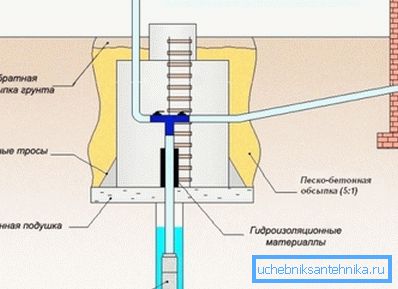
As can be seen from the figure, everything is quite simple, you should consider only a few factors:
- First, the pit is cleared in which the well design will be arranged. On the floor should be poured concrete screed - a solid foundation is important.
- The body itself can be ready - from metal or plastic, or erected from concrete or brick. It must be of such a size as to ensure the convenience of being in it at least one person.
- It is better to fill the space around the body with gravel or rubble to create a drainage layer.
- Great importance should be given to the places of exit of the pipe from the caisson, they must be sealed and sealed.
Recently, large caissons have become increasingly common, which represent a whole room underground, and there are a switchboard, a pump, and even a storage tank. This method allows you to remove all the equipment from home.
Tip! It is not necessary to save on the size of the caisson, too small space will not once again bring a lot of inconvenience when servicing or washing the well. The extra meter of space will make the structure much more practical.
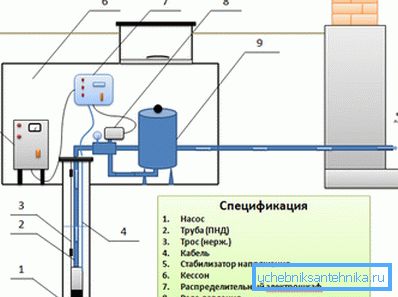
Pipeline from the caisson to the house
This part of the system is also very important, so we will analyze it in more detail:
- To enter the water in the house used pipes with a diameter of 25 or 32 mm. Ideal - metal-plastic solid piece from the caisson to the house. This material is very reliable, resistant to corrosion, and it can be easily bent and given the right direction without welding and soldering.
- To lay a trench dug, the depth of which should be below the level of soil freezing in your area. If it is not possible to make it so deep for some reason, or the entry point is higher, pipes must be insulated with a special material that will protect the water from freezing.
- Also, an electric cable is pulled in parallel with the pipe, it is better if it is a heating cable - this will protect the main line from frost. The cable is attached to the pipe along the entire length with adhesive tape, as shown in the diagram.
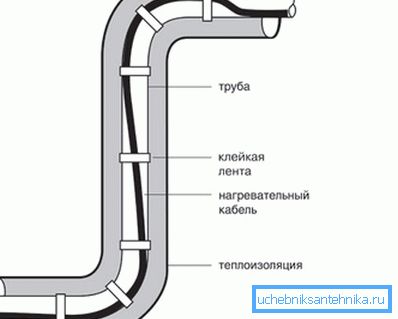
- Some prefer not to use a heat insulator, but a case from a sewer or asbestos-cement pipe. It will protect the pipe from damage during various earthworks.
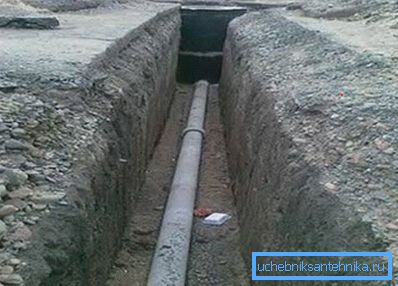
System with automated pump station
Most often this type is used if the depth of the well is not very large.
The system has a number of features:
- The pump must have sufficient power to deliver water from the well to a special tank that serves as a hydroaccumulator. Its capacity is determined depending on your needs for water and, as a rule, ranges from 100 liters to one and a half tons.
- In the tank is a special relay and membrane. Thanks to this system, the pump is turned on only when the amount of water is reduced. This allows the equipment to work more evenly.
- Capacity is most often located in any convenient place of the building, most often it is a basement or utility room.
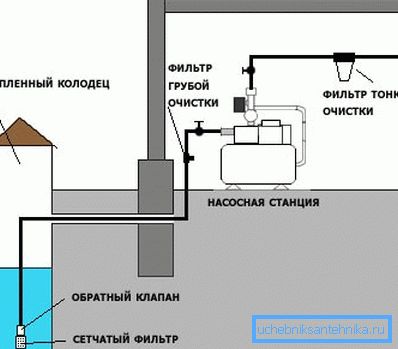
- Another important note on this type of system: the coarse filter is located in front of the pump, and the fine filter for the well - after it, before the water enters the tank for consumption.
Note! The pumping system requires a quality pipeline. If there is an air leak somewhere, the pressure in the system will drop, and the pump may burn, as it will work without water.
System with deep well pump
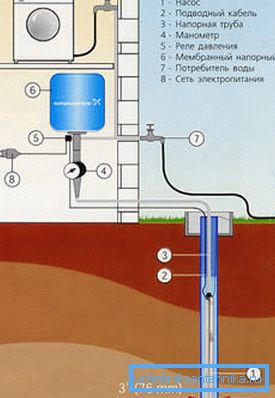
This scheme has several features:
- The main node is a submersible pump; it pumps water from a source into a storage tank in the house. You can arrange it in any convenient place, the capacity depends on the needs for water. For example, it is better to equip a house for an average family with a shower cabin with a capacity of at least 500 liters.
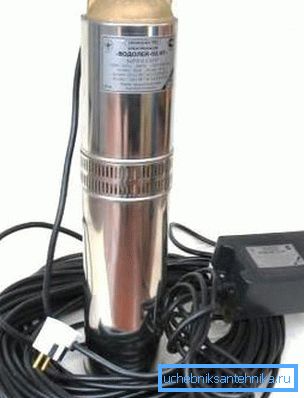
- The tank should be made of food-grade plastic or stainless steel - only these materials guarantee the safety of use and the absence of harmful discharges into the water.
- A very smart solution is to have a large tank in the attic. Then even in the absence of electricity, you will have a supply of water that will flow from the taps by gravity.
- The right choice of the pump is also of great importance - its capacity should be equal to the maximum water flow. Calculate it easily: each tap consumes 0.5 m3 per hour, if the house has 10 cranes, you need a pump with a capacity of 5 m3at one o'clock.
- The pump is placed on the cables and lowered with a winch in the caisson room. At least once a year it is necessary to take out the equipment and check its condition and the condition of the cables.
- To maintain pressure in the system and prevent outflow back into the well, it is better to install a check valve above the pump.
The price of such systems is quite significant, its value depends on many factors: the depth of the well, the length of the pipeline, the type of system chosen and the equipment used. The water supply scheme from the well can be very different, as now there are a lot of high-tech devices that make operation even more comfortable.
Features of independent work
The water supply scheme of a cottage from a well is simple enough, but you should know a number of nuances that should be followed in order to achieve system reliability:
- For lowering and fixing the submersible pump is best to use a manual or electric winch. And the work on the descent is done together: one person controls the winch, and the second adjusts and delivers the hose and electrical cable. The easiest way to attach the cable to the hose, and the mount should not be rigid, so that you can move the wire.
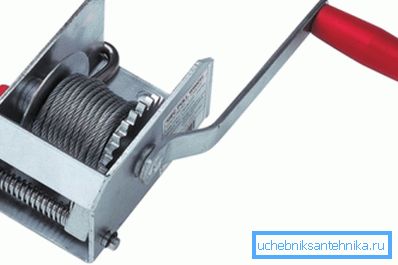
- You should also take care of the quality of the pipeline from the caisson to the house - if it is located above the freezing level, then it must be placed in a special insulating casing. And do not forget that the easiest way to hold the cable in parallel with the pipe, among other things, you can take the heating wire, and it will heat the pipe.
- Next, set the expansion tank, which will save a certain amount of water and facilitate the work of the pump. The container should be made of food materials, as indicated by a special stamp.
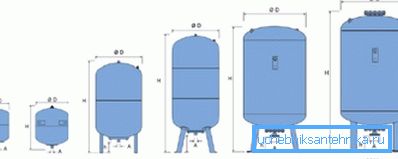
- To maintain a constant indicator of pressure in the system, you must add a relay and a membrane receiver. Thanks to this equipment, the pressure in the system rises and falls smoothly, which has a positive effect on the durability of the pump, because it is not subjected to sharp hydraulic impacts, which would be inevitable.
- You should also pay attention to the choice of high-quality pipe fittings and the pipes themselves. All taps and fittings must be strong and of high quality so that you do not come home and do not find that the floor is filled with water.
- Most often, plastic pipes are used for distributing pipes around the house. They are durable, durable, and convenient to work with them. The connections are made with a soldering iron, which costs only $ 50. With him comes a small instruction, after reading that, you can easily master all the wisdom of this process.
- And do not forget that you need to install several filters: deferrization, softening, cleaning of mechanical impurities. And you can put a whole system that will not only purify the water, but also saturate it with useful trace elements.
Tip! Before starting work, it is best to invite a specialist for consultation. It will not be too expensive, but it will give many useful recommendations that will help to do the work more efficiently and reliably.
In general, the work on the device of water supply from the well, require scrupulous attitude and accuracy. You should not save on any nodes, because the failure of any small parts can lead to breakage of expensive nodes. The entire system must be carefully checked before daily use to avoid unpleasant surprises in the future.
Conclusion
Providing a house with water from a well is more laborious in comparison with water supply, but the quality of water will be at the highest level. Therefore, do not be afraid of difficulties, because it is the water supply of your home. The video in this article will help sort out some issues.